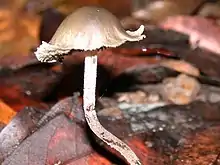Panaeolus acuminatus
Panaeolus acuminatus, also known as Panaeolus rickenii, is a species of mushroom in the family Bolbitiaceae.
| Panaeolus acuminatus | |
|---|---|
 | |
| Scientific classification | |
| Domain: | Eukaryota |
| Kingdom: | Fungi |
| Division: | Basidiomycota |
| Class: | Agaricomycetes |
| Order: | Agaricales |
| Family: | Bolbitiaceae |
| Genus: | Panaeolus |
| Species: | P. acuminatus |
| Binomial name | |
| Panaeolus acuminatus | |
| Synonyms[1] | |
| |
| Panaeolus acuminatus | |
|---|---|
| Gills on hymenium | |
| Cap is convex | |
| Hymenium is adnexed | |
| Stipe is bare | |
| Spore print is black | |
| Ecology is saprotrophic | |
| Edibility is unknown | |
This species contains small amounts of serotonin, 5-HTP, and tryptophan.
Description
P. acuminatus is a small brown mushroom that has black spores. It has a cap that is less than 4 cm across, hygrophanous, conic to campanulate to plane, usually with an umbo. The gills are dark purplish black, crowded, with several tiers of intermediate gills. The spores are (11) 13 - 15 (17) x 9 - 11 (12) x (6.5) 7 - 8 (9) micrometers, smooth, black, and shaped like lemons.[2] Cheilocystidia present.
Habitat and distribution
P. acuminatus grows in grass and dung. It has been found throughout North America and Europe and is very widely distributed.
See also
References
- Panaeolus acuminatus (Schaeff.) Quél., 1874. Retrieved through: Interim Register of Marine and Nonmarine Genera on 31 December 2022.
- Gerhardt, E: Taxonomische Revision Gattungen Panaeolus und Panaeolina, page 73. 1996
This article is issued from Wikipedia. The text is licensed under Creative Commons - Attribution - Sharealike. Additional terms may apply for the media files.